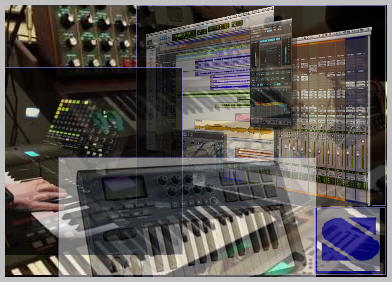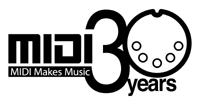
MIDI - Musical Instrument Digital Interface

What
Is MIDI?
Simply stated, the Musical Instrument Digital Interface, or MIDI, is a
digital communications language and compatible hardware specification
that enables multiple electronic instruments, performance controllers,
computers, and other related devices to communicate with one another
within a connected network.
MIDI is used to translate performance- or control-related actions (such
as playing a keyboard, selecting a patch number, or varying a
modulation wheel) into equivalent digital messages. It then transmits
these messages to other MIDI devices where they can be used to control
their sound generation or control parameters in a performance setting.
Alternatively, MIDI data can be recorded into a digital device (known
as a sequencer) that can be used to record, edit, and playback MIDI
performance data.
System Interconnection
MIDI enables 16 channels of performance, controller, and timing data to
be transmitted—in one direction—over a single data
line. Consequently, it’s possible for a number of devices to
be connected within a network through a single data chain for
communicating MIDI messages.
A MIDI cable consists of a shielded, twisted pair of conductor
wires that has a male 5-pin DIN plug located at each end. The
MIDI specification presently uses only three of the possible
five pins, with pins 4 and 5 being used as conductors for MIDI
data, and pin 2 being used as a ground connection. Pins 1 and
3 currently are not in use but are reserved for possible
changes in future MIDI applications.
Computer-Based Sequencers
Sequencers also are available as software packages that use the
personal computer for performing central processing, memory, and I/O
(input/output) functions. These systems are often powerful and
extremely versatile in their speed, digital signal processing
capabilities, memory management, and their capability to perform a
diverse range of tasks under software control.
As you might expect, sequencing software is available for most Apple
and IBM compatible machines. The majority of these computers require an
external MIDI interface that is used for receiving and distrubuting
MIDI data.
Computer based sequencers have several advantages over their
hardware-based counterparts. One of the strongest advantages is easy
visibility and access to both basic and advanced editing functions,
resulting from the PC’s extensive DSP and graphics
capabilities. Using standard cut-and-paste methods it becomes a simple
matter to move a musical segment from one track to another, cut a
musical passage from a song and save it to clipboard memory for later
use, or copy a passage to a track. In addition, the large screen and
established graphics interface style make it much easier to perform a
complex function. Graphics pattern editing also lets the user quickly
and easily change the pitch, start, and duration of times of a note as
it appears on the screen (in a style known as piano roll editing),
often through the simple movement of a mouse.
Because computer-based sequencers make use of the PC’s memory
management capabilities, sequenced files can be easily stored onto
either hard or floppy disks, while note capacity is usually restricted
only by the PC’s amount of internal RAM.
Sequencers
One of the most important devices in MIDI production is the MIDI
sequencer. A sequencer is a digitally based device or a computer
program that is used to record, edit, and output performance-related
MIDI data in a sequential fashion. The recorded MIDI-related channel
and system messages commonly represent real-time or non-real-time
performance events such as note on/off, velocity, modulation,
aftertouch, and continuous controller messages. After a performance has
been “recorded” into a sequencer’s or a
computer’s internal memory, the data can be edited and saved
to hard or floppy disk. When the sequence is played back, the device
outputs these MIDI messages to the various connected MIDI devices
within the system to re-create the performance. Unlike a recorded
performance in which the instrument’s sounds are produced
under the direct control of a live player, a sequencer communicates
real-time performance data to various electronic instruments, which in
turn produce the performed sound.
Most sequencers have a design similarity to their distant cousin, the
multitrack tape recorder, in that MIDI data can be recorded onto
separate “tracks” that contain isolated, yet
related, performance material that is synchronous in time. Each of
these tracks can be assigned to any MIDI channel and may contain any
number of performance-and control-related messages (within the memory
constraints of the device). When played back, the instruments and
devices in the system that are assigned to a specific MIDI channel
(0-16) respond only to track (or tracks) transmitting on that
particular channel.
The number of individual tracks offered varies widely from one
manufacturer and model type to the next and ranges from 8 to over 500
tracks. Almost every system is capable of transmitting and receiving
data over all 16 MIDI channels, although most professional sequencers
can communicate data over two or more independent MIDI data lines,
which enables them to address 32 or more separate MIDI channels.
Another important feature offered by most sequencers is the capability
to edit MIDI data in the digital domain. Standard cut-and-paste editing
techniques generally are offered, which enable segments of sequenced
data to be cut, copied, or reinserted at any point in a track or to any
other track. Complex algorithms for performing such tasks as velocity
changes, modulation and pitch bend, transposition, and humanizing (the
controlled randomization of performance data to approximate human
timing errors that are generally present in a live performance), as
well as control over program or continuous controller messages, can
also be inserted and changed.
The MIDI Interface
Although both the MIDI protocol and the personal computer communicate
through digital data, a digital hardware device known as a MIDI
interface must be used to translate MIDI’s serial message
data into a structure that can be understood by and communicated to the
computer’s internal operating system. MIDI interfaces such as
the Midisport series, as well as a full line of USB Midi keyboards and
control surfaces, are available
today.
Benefits
of MIDI
 MIDI
is a technology that represents music in digital form. Unlike other
digital
music technologies such as MP3 and CDs, MIDI messages contain
individual
instructions for playing each individual note of each individual
instrument. So
with MIDI it is actually possible to change just one note in a song, or
to
orchestrate and entire song with entirely different instruments. And
since each
instrument in a MIDI performance is separate from the rest, its easy to
"solo" (listen to just one) individual instruments and study them for
educational purposes, or to mute individual instruments in a song so
that you
can play that part yourself.
MIDI
is a technology that represents music in digital form. Unlike other
digital
music technologies such as MP3 and CDs, MIDI messages contain
individual
instructions for playing each individual note of each individual
instrument. So
with MIDI it is actually possible to change just one note in a song, or
to
orchestrate and entire song with entirely different instruments. And
since each
instrument in a MIDI performance is separate from the rest, its easy to
"solo" (listen to just one) individual instruments and study them for
educational purposes, or to mute individual instruments in a song so
that you
can play that part yourself.

MIDI is a
trademark of MIDI Manufacturers Association Incorporated.
About MIDI -
Making Music with MIDI
- MIDI Controllers -
MIDI Products -
MIDI Glossary
-
MIDI Polyphonic
Expression (MPE)

